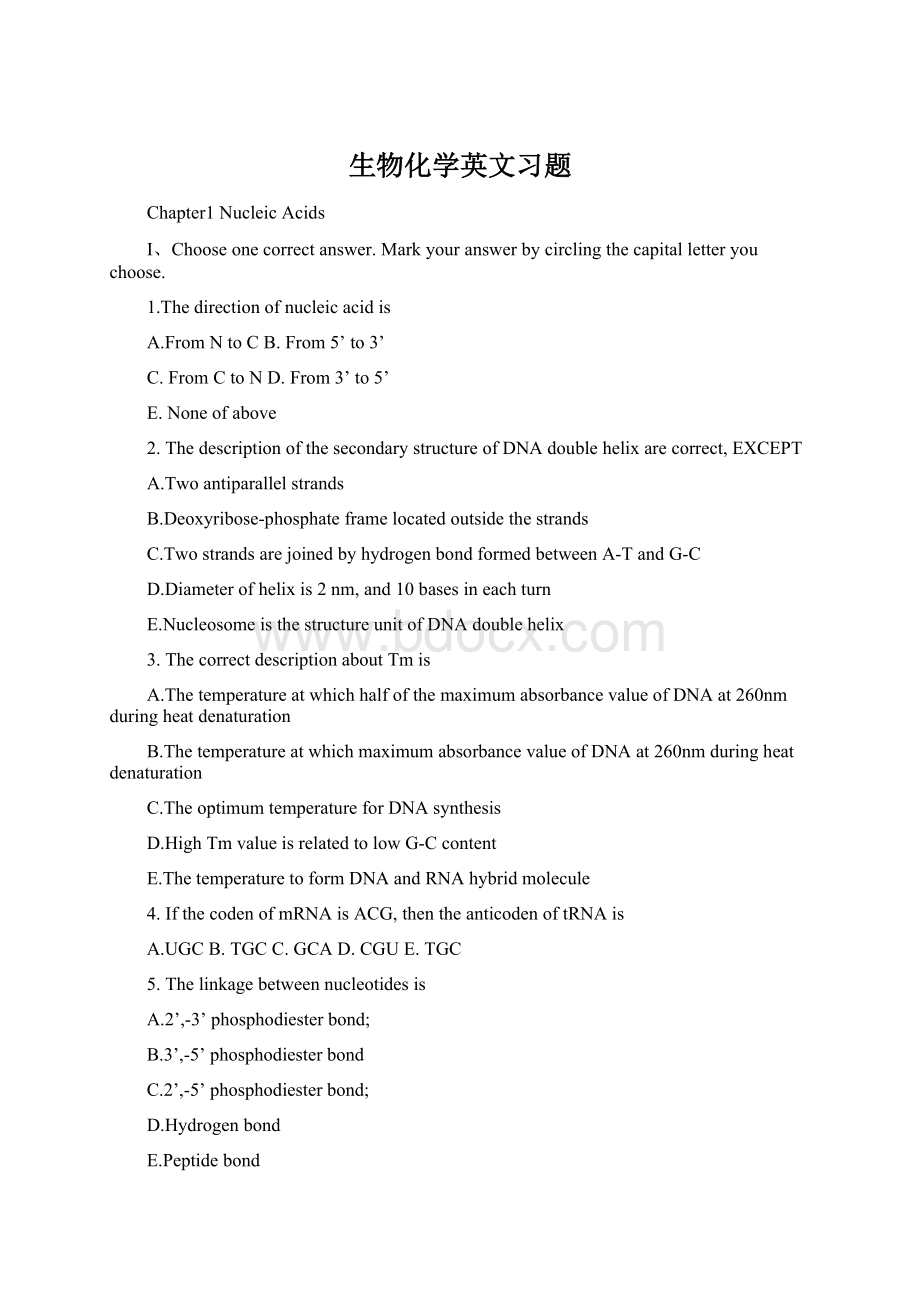生物化学英文习题Word格式.docx
《生物化学英文习题Word格式.docx》由会员分享,可在线阅读,更多相关《生物化学英文习题Word格式.docx(30页珍藏版)》请在冰豆网上搜索。

B.3’,-5’phosphodiesterbond
C.2’,-5’phosphodiesterbond;
D.Hydrogenbond
E.Peptidebond
6.ThetemplatestrandofDNAis5’-ATTCAG-3’,itstranscriptis
A.5’-GACTTA-3’
B.5’-CTGAAT-3’
C.5’-UAAGUC-3’
D.5’-CUGAAU-3’
E.5’-TAAGTC-3’
II、Fillintheblanks.
1.EukaryoticmRNAscanbemodifiedaftertranscriptionatthe5’endwithamodifiedresiduecalleda____________,atthe3’end80to250Aresiduesareaddedtocreatea____________.
2.Eachnucleotideconsistsofthreecomponents,_____________,______________,______________.
3.TheconformationforDNAproposedbyWatsonandCrickiscalledBform,theothertwoconformationsexistinginthecellare____________,______________.
III、Explainthefollowingterms.
1.Hybridizationofnucleicacids
2.Tm
3.ribozyme
4.codon
5.anticodon
6.Hyperchromiceffect
7.DNAdenaturation
8.Annealing
9.snmRN
10.nucleosome
Ⅳ、Brieflystatethefollowingquestions.
1.StatethefunctionsofthreemajorkindsofRNA(mRNA,tRNAandrRNA).
2.PleasedescribethesecondarystructureofDNAproposedbyWatsonandCrick.
3.StatebrieflythedifferencesbetweenDNAandRNA.
4.PleasedescribethestructuralfeaturesofeukaryoticmRNA.
Chapter2Proteins
1.Allofthefollowingaminoacidsareacidicorbasicaminoacids,EXCEPT
A.Asp
B.Glu
C.Lys
D.Arg
E.Ser
2.
12.Whichisthelinkagebondforthepeptide?
A.Hydrogenbond
B.Peptidebond
C.Hydrophobicinteractions
D.Electrostaticinteraction
E.3’,5’–phosphodiesterbond
3.Theproteinmolecule(pI=6.5)willmobilethetopositiveelectrodewhenthepHofelectrophoresisbufferis
A.pH=3.0
B.pH=4.0
C.pH=5.0
D.pH=6.5
E.pH=8.0
4.Theaminoacidinproteinsis
A.L-β-aimnoacids;
B.D-β-aimnoacids;
C.L-α-aimnoacids;
D.D-α-aimnoacids;
E.Allofabove
5.Thechemicalbondinchargeofmaintainingsecondarystructureofproteinsis
A.Saltbridge;
B.Disulfidebond
C.Hydrogenbond;
D.Peptidebond;
E.Hydrophobicinteraction
6.Thechemicalbondinchargeoftheprimarystructureofproteinsis
E.Phosphodiesterbond
II、Fillintheblanks:
1.Thesecondarystructuresofproteininclude___________,___________,___________,and___________.
2.Theabsorbancepeakvalueofproteinisat___________nm,andthatofthenucleicacidisat___________nm.
3.Theforcemaintaininghigherstructureofproteinsarenoncovalent.Theyare______________,______________,_______________,________________.
1.GSH(glutathione)
2.Motif
3.proteindenaturation
4.petptideunit
5.domain
6.pIofprotein
7.α-helix
8.Peptidebond
9.aminoacidresidue
10.saltingout
1.Listtheapproachescommonlyusedinseparationandpurificationofproteinmolecules,andexplainsimplythemajormechanismofeachone.
2.Brieflyexplainthestructuralfeaturesandclassificationofaminoacidsconstituteofdifferentproteins.
3.Whatisprimarystructureofprotein?
Pleasestatetherelationshipsbetweentheprimarystructureandfunctionsofproteinsbyanexample.
Chapter3Vitamins
1.VitaminDbelongsto
A.Fatsoluble
B.Watersoluble
C.BothAandB
D.Insoluble
E.Notaboveall
2.TheactiveformofVitaminDis
A.25-(OH)D3
B.1,25-(OH)2D3
C.1,24,25-(OH)3D3
D.24,25-(OH)2D3
3.Theactiveformoffolicacidis
A.F
B.FH2
C.FH4
D.NAD+
E.FAD
4.Thedeficiencyofwhichwillcauseanmia?
A.VitaminB6
B.VitaminB12
C.FH4
D.Alloftheabove
1.____________and____________arethecofactors(coenzymes)ofthedehydrogenases,andtheyarederivedfromVitaminB2;
____________and____________arealsothecofactors(coenzymes)ofthedehydrogenases,andtheyarederivedfromVitamin____________.
2.TheactiveformsofvitaminAare____________,___________and___________.AnearlysymptomofvitaminAdeficiencyis___________
1.provitaminA
2.lipid-solublevitamins
3.water-solublevitamins
TrytoexplainthebiochemicalfunctionsofvitaminCanditsdeficiencies.
Chapter4Enzymes
1.Thefactorsrelatedtothekineticsofenzymereactionareincluded,EXCEPT
A.pHandtemperature
B.[Enzyme]
C.[Substrate]
D.Inhibitor
E.Time
2.Aboutcompetitiveinhibitors,whichofthefollowingisNOTtrue?
A.Similartothesubstrates
B.Bindtotheactivecentreoftheenzymes
C.Bindtotheenzymereversibly.
D.Bindtotheenzymebynon-covalentbond
E.Noneoftheabove
3.Aboutnon-competitiveinhibitors,whichoneistrue?
A.Km↑,Vmaxremainsconstant
B.Km↑,Vmax↓
C.Kmremainsconstant,Vmax↓
D.Km↓,Vmax↑
E.Km↓,Vmaxremainsconstant
4.Inhibitionofphosphatepesticideoncholineesterasebelongsto
A.Irreversibleinhibition
B.Reversibleinhibition
C.Competitiveinhibition
D.Noncompetitiveinhibition
E.Uncompetitiveinhibition
1.Theessentialgroupsinactivecenterofanenzymeare______________and_________________.
2.Holoenzyme=_____________+____________.
3.Thethreepropertiesofenzymaticcatalyzedreactionsare_____________,______________,_________________.
4.WhenVequalsto80%Vmax,[S]=______Km.WhenVequalsto90%Vmax,[S]=______Km.
5.Thespecificitiesofenzymescanbebrieflydividedintothreetypes:
_____________,______________and________________.
1.Isoenzyyme
2.Km
3.Activecenterofanenzyme
4.Allostericenzyme
5.Competitiveinhibition
6.Optimumtemperature
1.Whatistheactivationofzymogen?
Statethebiologicalsignificanceoftheprocess.
2.BrieflystatethesignificanceofKmandVmax.
3.Comparethecharactersofthreetypesofreversibleinhibition.
Chapter5CarbohydrateMetabolism
1.TheuniquepathwayformatureredbloodcellstoobtainATPis()
A.pentosephosphatepathway B.tricarboxylicacidcycle
C.β-oxidationoffattyacid D.glycolysis
E.gluconeogenesis
2.WhichcompoundcanNOTbeusedtodogluconeogenesis?
A.Acetoacetate
B.Glycerol
C.Pyruvate
D.Glutamate
E.Succinate
3.ThepathwayformatureredbloodcellstoobtainNADPHis()
A.pentosephosphatepathway B.tricarboxylicacidcycle
4.Inthemuscle,glucose6-phosphhatecanconvertintothefollowingcompoundsEXCEPT
A.Glycogen
B.AcetylCoA
C.Lactate
D.Glucose
E.Fructose6-phosphate
5.WhichcompoundisNOTthecoenzymeofpyruvatedehydrogenasecomplex?
A.FAD
B.NAD+
C.Biotin
D.CoASH
E.Lipoicacid
6.Whichenzymeisthekeyenzymeinglycogenolysis(glycogendegradation)?
A.Phosphorylase
B.Hexokinase
C.Phosphoenolpyruvatecarboxykinase
D.HMG-CoAreductase
E.Pyruvatekinase
1.Theactiveformofglucoseinglycogenesisis,theactiveformofcholineinphospholipidsynthesisis,theactiveformofSO42-insulfationis,theactiveformofmethylinmethylationis.
2.Glucose6-phosphate(G-6-P)isanimportantintermediatecompoundinvolvedinthecarbohydratemetabolismpathways,e.g.,____________,____________,____________,____________,and____________.
1.Glycolysis
2.Tricarboxylicacidcycle
3.Pentosephosphatepathway
4.Glycogenesis
5.Glycogenolysis
6.Gluconeogenesis
7.Bloodsugar
8.Coricycle(Lactatecycle)
9.Glycogenosisorglycogenstoragedisease
10.Aerobicoxidation
Ⅳ、Brieflystatethefollowingquestions.
1.Themajorfunctionofpentosephosphatepathway.
2.ListthemajorproductsofTricarboxyliccycleandpentosephosphatepathways,andstatetheirbiologicalsignificance.
3.Simplystatetheseveralstepsofaerobicoxidationpathway.
4.Statethesource,fateandregulationofbloodglucose.
Chapter6BiologicalOxidation
1.TheorderofthemembersofNADHoxidativerespiratorychainis
A.NAD+→complexII→complexI→CoQ→complexIII→cytochromeC→complexIV
B.NAD+→complexI→complexIII→CoQ→cytochromeC→complexIV
C.NAD+→complexII→complexIII→CoQ→complexC→complexIV
D.Co